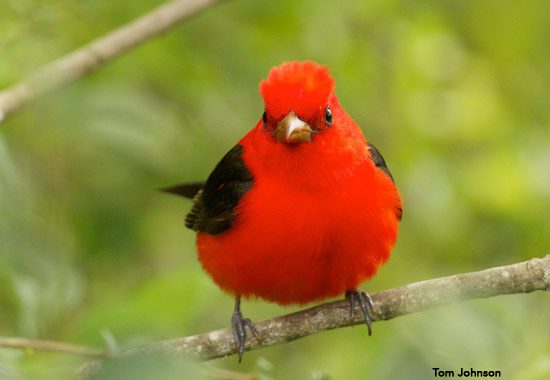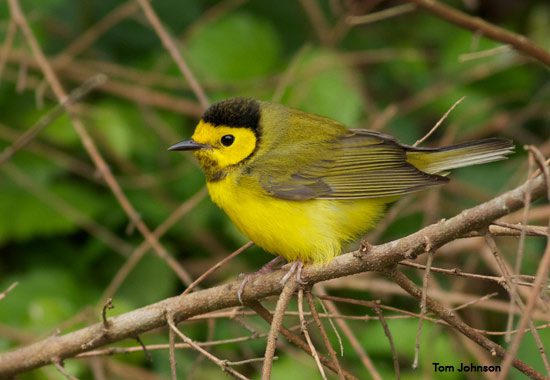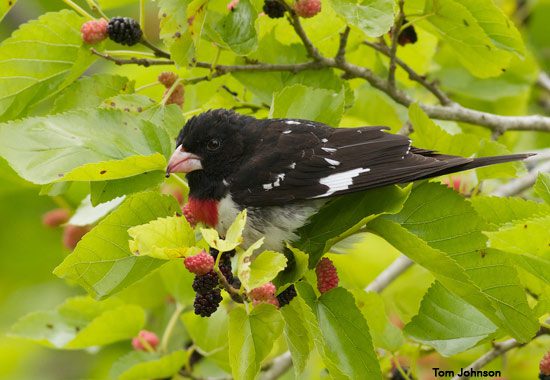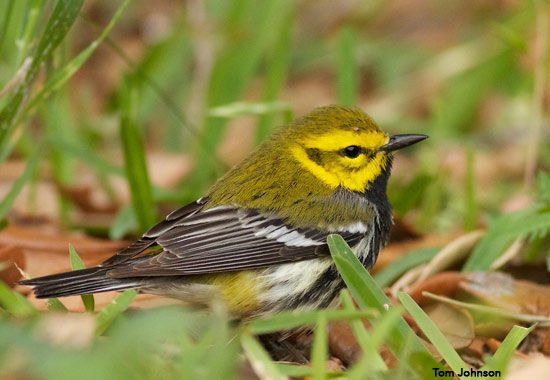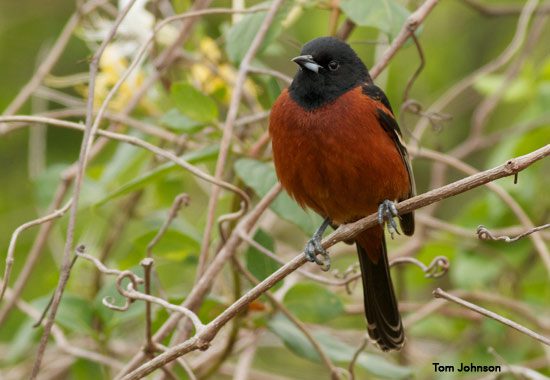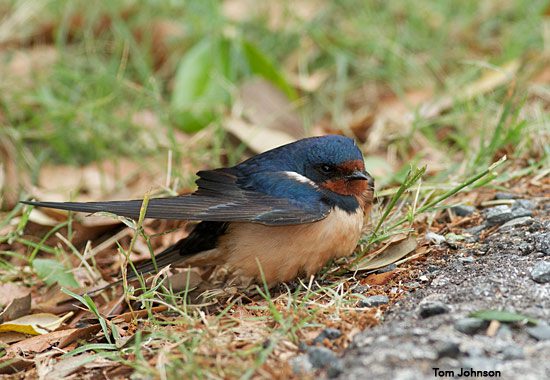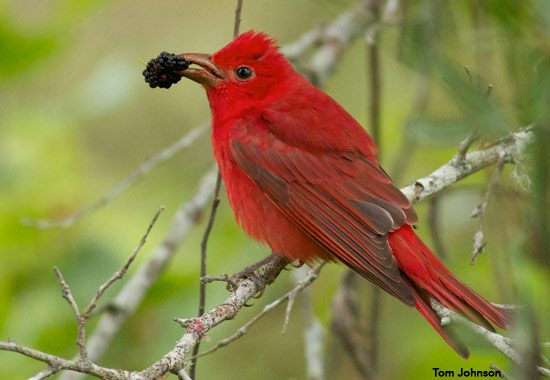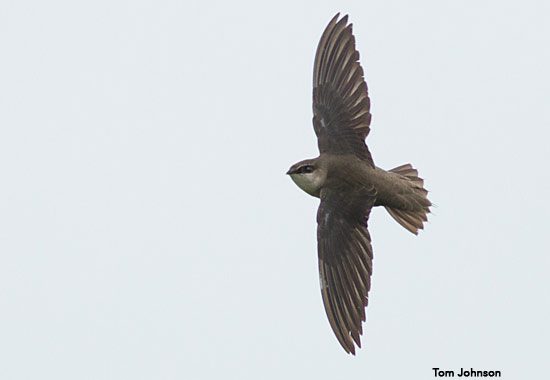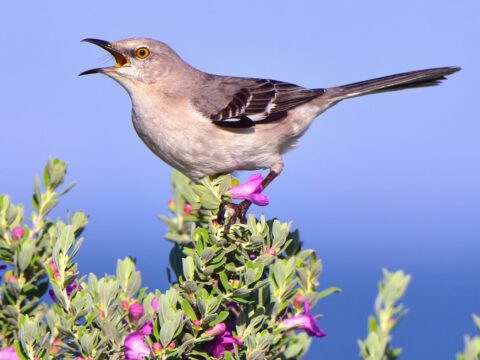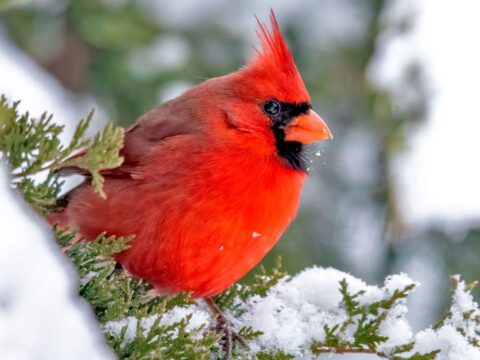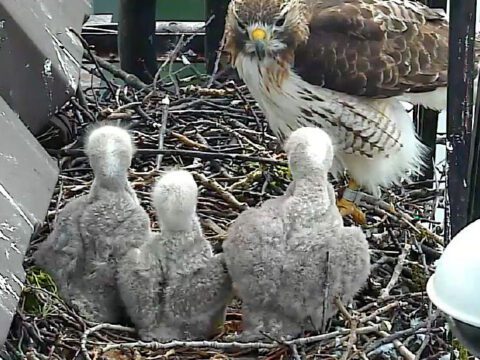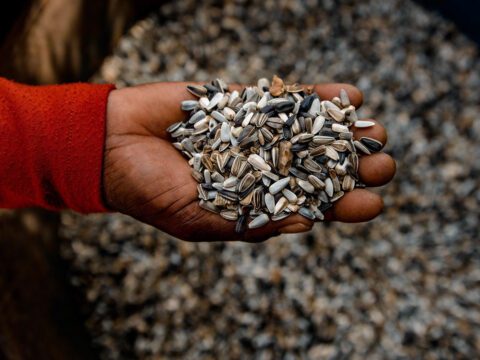294 Species and One Shattered Record on “Almost Perfect” Big Day
April 27, 2013
Scenes from the High Island migrant fallout: Scarlet Tanager by Tom Johnson. 
Hooded Warbler by Tom Johnson. 
Rose-breasted Grosbeak by Tom Johnson. 
Black-throated Green Warbler by Tom Johnson. 
Orchard Oriole by Tom Johnson. 
Barn Swallow by Tom Johnson. 
Summer Tanager by Tom Johnson. 
Chimney Swift by Tom Johnson.
As midnight struck on Thursday, April 25, 2013, the six members of Team Sapsucker made North American history with 294 species recorded in a single day—a new record. Buoyed by good weather, excellent scouting help, and one of the largest migration fallouts in recent memory, they raced from the desert washes of south-central Texas to the live oaks of the coast to amass a total larger than almost anyone had imagined possible.
In 2011, Team Sapsucker—Chris Wood, Jessie Barry, Andrew Farnsworth, Marshall Iliff, Tim Lenz, and Brian Sullivan—had set a new record with 264 species. That was three more than the previous high mark. In 2012 they returned to Texas and managed to repeat their result. It seemed as if Texas’s potential might be reaching a plateau, which is why it was on no one’s radar (except for the Sapsuckers themselves) that this year’s total would be a full 30 species higher.
“We’ve always known, or at least had some faith, that 300 is possible,” Iliff said. “But it requires not only perfect planning and perfect execution, which is hard enough, but it also requires perfect weather. Somehow this year all those things happened.”
Early on, the Sapsuckers knew this year could be special. A weather forecast was calling for an unusually strong cold front to make it through Texas and out into the Gulf of Mexico. At the same time, conditions in the Yucatan Peninsula were ideal for migrants to begin their long flight north. “When migrants meet these fronts it’s a serious challenge for them,” said Andrew Farnsworth, a bird migration expert and project leader for BirdCast. “They hit rain and strong winds, they look for the closest coastal habitat they can find, and they fall out.” After two straight years of strong south winds and poor migrant turnout, it looked like Thursday could bring calm conditions and migrants galore.
On Wednesday, a report from High Island by team scout Tom Johnson whetted their appetite. Later, he described the scene:
On Wednesday morning as I headed west on the Bolivar Peninsula, I started to notice large waves of Barn Swallows and Chimney Swifts arriving from offshore. I started to see Rose-breasted Grosbeaks, Scarlet Tanagers, and Yellow-billed Cuckoos flying low over the beach and landing in marginal shrub habitat, so I hightailed it back to High Island, the only substantial strip of coastal forest for dozens of miles around. The woods had turned into a rush of color. Summer and Scarlet Tanagers were attempting to make landfall after a tough water crossing into north winds. Tennessee Warblers, 330 of them, streamed across 5th Avenue and toward Smith Oaks, a Houston Audubon preserve. Orioles, grosbeaks, and buntings were everywhere. Hundreds of warblers were zipping around the treetops, while others poked around on grassy areas and bare trails, trying to refuel after their marathon flight.
The migrants were good news, but they also meant the team had to pack all their scouting into fewer days. Normally they have a full week to ferret out every last rarity and make endless recalculations to their carefully timed itinerary. In the end, they were still making route adjustments up until the night before. At 6:00 p.m. on Wednesday they decided to allot 30 minutes to a great duck and shorebird spot near San Antonio called Mitchell Lake, but this meant staying up until 10:00 figuring out where to win back the time elsewhere in the route. Then to bed, maybe—they were getting up at 10:30.
A lot of strategy goes into a Big Day. To best coordinate the route, they divide the day into thirds and a two-person team takes responsibility for leading each third. Marshall Iliff and Tim Lenz handled the morning in San Antonio and the Hill Country; Andrew Farnsworth and Brian Sullivan planned out the central portion all the way to the piney woods east of Houston; and Jessie Barry and Chris Wood orchestrated the final push from 4:30 onward into the migration hotspots and shorebird flats of High Island and Bolivar Peninsula.
The team got into position before midnight and began their day with a rare Ross’s Goose that had been hanging out at a suburban park near San Antonio. From there the team hopscotched to Uvalde, pausing for opportune species—a robin and a Blue Jay whose nests were lit by streetlights; pauraques, poorwills, Chuck-will’s-widows; two nighthawks and five owls. By the time dawn broke they were on a quiet road in the desert listening for Scaled Quail, then racing to Chalk Bluffs for a dawn chorus worth 79 species.
Though it wasn’t 8 a.m. yet, the day began to pick up its pace. Racing up a hillside after a Black-tailed Gnatcatcher, Andrew Farnsworth watched Brian Sullivan tumble over some barbed wire; on the way back down Farnsworth snagged the exact same strand. The team had to use their full supply of safety pins to repair his pants leg. Iliff briefly raised blood pressures by driving into the Uvalde dump after a Chihuahuan Raven—the same choice that last year led to a flat tire and an hour’s delay. This year: no flat tire, but no raven.
The team’s last-minute decision to add Mitchell Lake paid off with hundreds of ducks and shorebirds, along with a half-dozen soaring raptors. Another detour that Farnsworth and Sullivan had fretted over also paid off in some wet fields near the Attwater Prairie Chicken National Wildlife Refuge. In the end, it was fast and productive: brake pedal, exit ramp, wet field, Le Conte’s Sparrow, Upland Sandpiper, on ramp, accelerator.
Now the team had to make it through Houston in midafternoon traffic. On the far side of the city, some of the last fingers of eastern piney woods creep down into Texas, and with it come Pileated Woodpeckers, Prothonotary Warblers, Brown-headed Nuthatches, and Red-headed Woodpeckers. A Swainson’s Warbler, a difficult bird to find at the best of times, sang on cue. A Bald Eagle soared above a reservoir. “And the whole time Brian and I were thinking ‘Oh geez, we’re not going to find any of these woodpeckers we scouted… we’re not going to have enough time,'” Farnsworth said. “We weren’t thinking about numbers, we were thinking about finding birds.”
“One of the hardest things about a Big Day is you have to stay on your pace,” Sullivan added. “When you miss a bird, you can’t linger on it. You just have to say ‘Oh well, we missed it. We’ve got to go,’ even if it’s just 30 seconds or a minute. Chris and Jessie’s portion of the route starts at 4:30, and if you’ve added minutes onto your day and you’re starting there at 5:15, you’re going to miss 30 birds later.”
When they hit High Island the migration fallout that had begun on Wednesday was still going on. All six of the Sapsuckers are serious, no-nonsense birders who know how to focus. But they’re also people who have loved looking at birds for as long as they can remember. They were having trouble concentrating.
“One of our biggest problems was being distracted by too many adult male Scarlet Tanagers and Rose-breasted Grosbeaks,” Iliff said. “We missed at least three or four species that way, probably more.”
“It was like being in a confetti of all different colors,” Farnsworth said. “It was beyond our abilities to comprehend and stay focused. These red and black Scarlet Tanagers were everywhere in your field of view, such an incredibly intense color, and we’d see 100 of them in a small area, everywhere you look, hopping on the ground.”
As good as the birding was, Barry kept pushing them forward. At one point, Philadelphia Vireos were so close at hand that Iliff photographed one using his iPhone. But despite the nagging sense that among those flitting masses there must be a new species or two—maybe a Bay-breasted or a Golden-winged Warbler—they needed to get to Bolivar with enough daylight to pick up the dozens of species that awaited them there: thousands of avocets, plovers, stilts, dowitchers, knots, yellowlegs, sandpipers, skimmers, gulls, and terns.
When the sun went down Iliff, in the passenger seat, started entering birds into his laptop. A big number at the top of his spreadsheet flashed the total, but he refused to look at it until he was done. All he could hear were Barry and Lenz, sitting behind him and gasping at the numbers; and Farnsworth and Sullivan in the back of the van, asking what was going on. They were at 292. They spent the rest of their time slapping mosquitoes at Anahuac National Wildlife Refuge, getting King Rail around 10 p.m. and then Virginia Rail at 11:41. As the clock struck midnight, they were still listening for a Black Rail’s kee-kee-kerr. It didn’t come.
A total of 294 immediately raises the question of whether 300 really is possible. For Wood, it’s hard to say. “It’s in the back of our minds as we do this,” he said. “We’re at this point in time where technology will continue to advance, and our knowledge about birds and their exact requirements will continue to increase. But the other question is will there still be areas for birds? The area where we went to see Seaside Sparrow and Nelson’s Sparrow—along that road out into this great estuary—it’s all slated to have homes built on it. And there’s questions like how long will these birds be able to continue moving in these types of numbers? It speaks to so much that the Lab does, and the power of partnerships with local organizations.”
He was talking about help the team had received from dozens of people: expert scouters, crack local birders, birding organizations, kind permission from landowners, and team sponsorship by Carl Zeiss Sports Optics. Scouters included Andy Guthrie, Matt Hafner, Cornell Lab conservation scientist Ken Rosenberg, and Cornell grad Tom Johnson. The team also thanks Michele Crawford, Grant Webber at the Uvalde Fish Hatchery, Neal’s Lodge, Susan Albert and the staff at the Mitchell Lake Audubon Center, National Audubon Society, Brad Wier at the San Antonio Botanical Gardens, Noreen Baker, Jimmy Laurent at Anahuac National Wildlife Refuge, Harvey Laas, John Berner, Elizabeth Eddins, George and Clarence at Beaumont Waste Treatment, and Patti Ryan, whose delicious cookies powered the team through the day.
(Images taken by Tom Johnson at High Island, Texas, over the last few days. You can still donate in support of Team Sapsucker’s record and to aid our conservation work. You can view the full species list in the team’s eBird checklist.)

All About Birds
is a free resource
Available for everyone,
funded by donors like you
American Kestrel by Blair Dudeck / Macaulay Library
